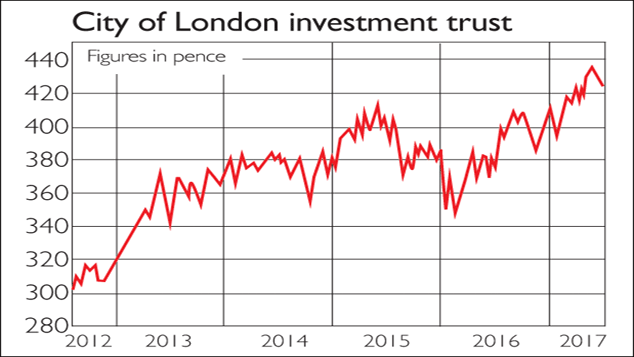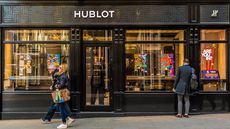How to spot the true “dividend heroes”
Investment trusts are increasingly drawing on capital reserves to boost dividends. Learn to identify and sidestep the tactic’s pitfalls and you could profit, says Sarah Moore.

Investment trusts are increasingly drawing on capital reserves to boost dividends. Learn to identify and sidestep the tactic's pitfalls and you could profit, says Sarah Moore.
The last time the City of London investment trust failed to increase its dividend was in 1966. Other events that year such as a certain team's World Cup victory have rather eclipsed this piece of financial history in the collective memory. However, the investment-trust enthusiasts among us will know that City of London now has a 50-year history of increasing its dividend payment. Along with Bankers Investment Trust and Alliance Trust, it holds the record for the longest period of consecutive dividend increases among investment companies. Those ever-increasing dividends could have made a huge difference to your wealth over that period if you'd stuck £100 in a bank account 50 years ago, it would now be worth just over £1,600, after inflation.
But if you'd put it in City of London and reinvested your dividends, it would be worth £56,000. That sort of return makes trusts like these and others with multi-decade dividend-raising records very appealing to those looking for a stable income, particularly in today's low interest-rate era. But how can you ensure that these payouts are actually sustainable?
Subscribe to MoneyWeek
Subscribe to MoneyWeek today and get your first six magazine issues absolutely FREE

Sign up to Money Morning
Don't miss the latest investment and personal finances news, market analysis, plus money-saving tips with our free twice-daily newsletter
Don't miss the latest investment and personal finances news, market analysis, plus money-saving tips with our free twice-daily newsletter
How did they do that?
Investment trusts have several features that distinguish them from open-end funds, as we explain in the box below. One key difference, which can make them especially appealing for income investors, is the ability of managers to hold back up to 15% of their gross annual income as revenue reserves. This enables them to build up a rainy day fund during the good years, to draw on during leaner years. This allows them to "smooth out" dividend payments over time, rather than cut them when hard times hit.
However, our prolonged era of low interest rates and slow growth has made it much harder for income-focused managers to track down consistent dividend payers. Because of this, some trusts have turned to more creative ways of maintaining headline-grabbing dividend records. In 2012 a rule change made it possible for investment trusts to fund dividend payments from capital profits (subject to shareholders' approval), as well as from income generated by the portfolio. In other words, trusts can "enhance" their dividend payouts with money made by selling shares for a profit, rather than just using dividend income.
This makes it easier for trusts to maintain consistent dividend levels, which on the surface is good for income investors. And more and more trusts are using the option. While the tactic is most common in the listed private-equity sector (where dividend income is typically low due to the nature of the companies invested in, and most profits are generated when the unlisted companies in the portfolio are sold), trusts from every area have now adopted the practice.Investment companies that have recently decided to boost their dividend payouts by dipping into their capital reserves include JPMorgan Global Growth & Income, JPMorgan Asian, International Biotechnology and the newly launched BB Healthcare.
Is it a good idea to draw on capital for income?
There's nothing wrong in itself with paying capital gains out to investors as dividends. Dedicated dividend investors often struggle with this idea, but at the end of the day we all invest to make a return on our money. In theory (and ignoring tax issues for now), whether that money comes from capital gains or income is beside the point. The difficulty arises from the potential lack of transparency. As Samuel Murphy of broker Numis puts it: "investors should seek to understand how a fund's yield is generated rather than just focus on the headline yield".
The main worry, he notes, is that the impact of using capital reserves to pay an enhanced dividend is "disguised" in rising markets because the value of the underlying portfolio (the net asset value, or NAV) is rising anyway, so the nibbling away of capital gains is not as obvious. However, the tactic will "accentuate NAV losses when markets fall", particularly if trusts feel forced to sell assets in weak markets in order to maintain dividend payouts.
Another point to be aware of when looking at an investment trust's dividend history is that managers are allowed to charge a proportion of fees and finance costs to the capital account. This means the earnings in the trust's revenue account are left available for distribution as dividends, but at the cost of the capital account. As you'd expect, equity income funds tend to charge more to capital than funds that prioritise capital growth, which have less incentive to boost their dividend. Most equity trusts charge 60% to 70% of management fees and finance costs to capital, note analysts from Numis. If all fees and finance charges were instead charged to revenue, the average yields for UK equity income investment trusts would fall from 3.4% to 3%.
"A combination of sustained or at least maintained dividends in the past is a tick in the box, but the capital position should also be considered," agrees Pascal Dowling of boutique investment manager Kepler. "It's not much use if your trust had paid a steady income but has lost a load of money at the same time, leaving you with nothing when you sell up."
Yet given where interest rates are, investors will have to get used to paying closer attention to where their dividends come from. "The yield offered by traditional sources of equity income is increasingly stretched. It makes sense... for investment trusts to use the assets they have at their disposal including the ability to draw income from capital to generate the income that investors crave."
On a more positive note, the ability to pay part of the dividends out of capital means that trust managers avoid the temptation to own risky high-yield stocks (which may end up having to cut their dividends in future) in favour of lower-yielding but safer stocks, argues Alex Paget on Trust Intelligence, a free investment-trust research website produced by Kepler. Another potential benefit of paying consistent and growing dividends is that a record of reliable payouts can entice other investors into the trust, in turn pushing up the share price and narrowing the discount (or even pushing it to a premium). This is positive for those invested in the trust, who will benefit from the capital growth.
Some commentators are now even promoting enhanced yields as a policy to help control the size of a trust's discount, note the analysts at Numis. This certainly seems to have worked for some trusts. For example, JPMorgan Global Growth & Income saw its discount narrow to around 3%, compared with 14% before it declared an enhanced dividend. Similarly, International Biotechnology's discount has narrowed from 15% to 9%.
However, Numis acknowledges that other factors might also have played a part in narrowing discounts, including periods of strong performance, sentiment towards the sector, and planned exit strategies. For example, it could be argued that Invesco Perpetual UK Smaller Companies trades at a tighter discount than its peers due to the board's commitment to offer investors the opportunity to exit at close to NAV by the 2017 annual meeting.
So if you're looking for an investment trust that can pay a reliable income, or are concerned about the viability of your current holdings, what should you look for in the funds' annual reports and accounts? The easiest option, says Dowling, is to look at the dividends section of a trust's reports and accounts. Look back over the past five to ten years and check out how well the trust has been able to increase or maintain its dividend over that period. Then take a look at current revenue reserve cover.
The revenue reserve indicates how big the investment trust's rainy day fund is it indicates how well the fund could cover the current dividend if it had to pay it purely from its reserves, rather than from its annual earnings. For example, if revenue reserve cover stands at 1, it means the trust has cover for a year. Anything over 0.6 is "okay", says Dowling, while more than 1 is "good". Ticking off these boxes means you at least have "proof that the trust has paid a dividend in the past and stuck to it, or increased it, and proof that it has money in the bank to maintain it if things head south in the markets".
Another metric to look at is dividend cover. This compares the trust's annual earnings to the size of the dividend it pays out. In other words, it shows whether the trust can actually cover its dividend with current earnings. Dividend cover can be expressed as a percentage, so a firm that has more than enough earnings to cover its dividend will have dividend cover of more than 100%; or as a multiple, whereby a fund with a dividend cover of two means the trust's earnings cover its dividend payout twice over.
If dividend cover falls below one, it suggests payouts will not be sustainable for long. Dividends for the majority of UK equity income trusts are currently fully covered, which means their revenue reserves are rising, reports Numis, and cover is likely to continue rising this year, as the weaker pound increases the value of dividends denominated in foreign currencies (mainly US dollars) from both UK and overseas-listed companies.
Finally, note that just because an investment trust has an impressive dividend history, solid revenue reserves and high dividend cover doesn't automatically mean it's worth buying. They're all good signs of a quality trust, but if it's a high-octane tech fund you're after, that's not what you'll be getting. Equally, just because a trust is dipping into its capital in order to enhance its dividend payouts, it's not a reason in itself to sell out.
Several perfectly good trusts have been granted the option to do so by their boards, including MoneyWeek perennial favourite Scottish Mortgage Trust, whose tech-focused shareholdings generate little income but lots of capital gains. However, as Ian Cowie notes on Citywire, shareholders (and boards) should be alert: "this new feature of the closed-end fund managers' tool box has not yet been tested by a sharp and sustained downturn in prices". Below we look at some investment trusts that should be able to meet your income needs even in tougher times.
Investment trusts: the basics
Investment trusts are companies that invest in other companies. Unlike open-end funds (Oeics and unit trusts), investment trusts are traded on the stock exchange like any other listed company. So whereas the price of a unit in an open-end fund is directly dictated by the value of its underlying portfolio, the price of a share in the investment trust is set by the market. As a result, you can sometimes buy an investment trust for less than the value of its underlying portfolio. When this happens, the trust is said to be trading at a discount to net asset value (NAV).
If a trust is trading on a discount of 10%, for example, then you can effectively buy £1 worth of assets for 90p. A trust can also trade at a premium to NAV. Before you invest in an investment trust, it's worth checking the discount or premium and comparing it to its average a 10% discount could represent a bargain buying opportunity for certain trusts, while for others it could be unusually narrow. Investment-trust managers are also able to borrow money in order to boost their investments if they have particularly high conviction about a trade. Finally, the trusts like any other listed firm have independent boards that are tasked with looking out for shareholders' interests and holding the managers to account.
Seven investment trusts to buy for income
Three investment companies have just passed the milestone of 50 years of consecutive dividend increases: City of London Investment Trust, Bankers Investment Trust and Alliance Trust. Close behind are Foreign & Colonial Investment Trust, boasting 46 years of consecutive dividend increases, Brunner Investment Trust on 45 years, and JPMorgan Claverhouse with 44 years.

Of the three 50-year veterans, City of London (LSE: CTY) pays the biggest income, with a current yield of around 3.8%. It trades at a 2% premium to NAV (slightly higher than the average over the past five years). At 0.42%, the trust also has one of the lowest ongoing charges figures in the industry. Dividend cover is 1.09 and revenue reserve cover stands at 0.6.
If you'd prefer a global equity alternative to City, Bankers (LSE: BNKR), trades at a 4% discount (a bit higher than the five-year average of around 3.5%), and on a dividend yield of 2.2% pays a slightly higher income than Alliance Trust. Dividend cover is just over 1, and revenue reserves cover is 1.3. A warning to the ethically inclined: tobacco features heavily in most income portfolios (as tobacco stocks are income stalwarts) so just be aware if you're tempted.
Investment manager Kepler has devised an income ratings system to score investment trusts, based on 16 metrics, including dividend consistency, revenue reserves, capital growth and drawdown. The "well-rounded" Perpetual Income & Growth (LSE: PLI), which invests heavily in consumer goods, healthcare and financials, is one of its favourites, ranking highly for both dividend (Perpetual's dividends have grown at 8% a year over ten years) and capital growth, as well as for average revenue reserve cover. The trust is on a near-8% discount. Another Kepler favourite, Edinburgh Investment Trust (LSE: EDIN), yields 3.4%, trades on a historically wide discount of 4.5%, and has dividend cover of roughly 1.1.
Both Finsbury Growth & Income (LSE: FGT) and Temple Bar (LSE: TMPL) are flagged by Numis as interesting funds with "differentiated approaches" to more mainstream rivals. FGT is a great trust that focuses on strong brands, but it yields less than 2%. Temple Bar which prides itself on being contrarian and recently took FGT's place in MoneyWeek's model investment trust portfolio offers a solid long-term track record, a low charge of 0.49%, and a dividend yield of roughly 3.2%.
Global equity fund Law Debenture (LSE: LWDB) another member of the model portfolio currently trades at an 11% discount, and has a 2.8% yield, reserve revenue cover of 1.2, and dividend cover of just under 1 (mainly because it is the only equity income trust recommended by Numis that charges none of its fees to capital).
Sarah is MoneyWeek's investment editor. She graduated from the University of Southampton with a BA in English and History, before going on to complete a graduate diploma in law at the College of Law in Guildford. She joined MoneyWeek in 2014 and writes on funds, personal finance, pensions and property.
-
 Coventry Building Society bids £780m for Co-operative Bank - what could it mean for customers?
Coventry Building Society bids £780m for Co-operative Bank - what could it mean for customers?Coventry Building Society has put in an offer of £780 million to buy Co-operative Bank. When will the potential deal happen and what could it mean for customers?
By Vaishali Varu Published
-
 Review: Three magnificent Beachcomber resorts in Mauritius
Review: Three magnificent Beachcomber resorts in MauritiusMoneyWeek Travel Ruth Emery explores the Indian Ocean island from Beachcomber resorts Shandrani, Trou aux Biches and Paradis
By Ruth Emery Published
-
 Invest in space: the final frontier for investors
Invest in space: the final frontier for investorsCover Story Matthew Partridge takes a look at how to invest in space, and explores the top stocks to buy to build exposure to this rapidly expanding sector.
By Dr Matthew Partridge Published
-
 Invest in Brazil as the country gets set for growth
Invest in Brazil as the country gets set for growthCover Story It’s time to invest in Brazil as the economic powerhouse looks set to profit from the two key trends of the next 20 years: the global energy transition and population growth, says James McKeigue.
By James McKeigue Published
-
 5 of the world’s best stocks
5 of the world’s best stocksCover Story Here are five of the world’s best stocks according to Rupert Hargreaves. He believes all of these businesses have unique advantages that will help them grow.
By Rupert Hargreaves Published
-
 The best British tech stocks from a thriving sector
The best British tech stocks from a thriving sectorCover Story Move over, Silicon Valley. Over the past two decades the UK has become one of the main global hubs for tech start-ups. Matthew Partridge explains why, and highlights the most promising investments.
By Dr Matthew Partridge Published
-
 Could gold be the basis for a new global currency?
Could gold be the basis for a new global currency?Cover Story Gold has always been the most reliable form of money. Now collaboration between China and Russia could lead to a new gold-backed means of exchange – giving prices a big boost, says Dominic Frisby
By Dominic Frisby Published
-
 How to invest in videogames – a Great British success story
How to invest in videogames – a Great British success storyCover Story The pandemic gave the videogame sector a big boost, and that strong growth will endure. Bruce Packard provides an overview of the global outlook and assesses the four key UK-listed gaming firms.
By Bruce Packard Published
-
 How to invest in smart factories as the “fourth industrial revolution” arrives
How to invest in smart factories as the “fourth industrial revolution” arrivesCover Story Exciting new technologies and trends are coming together to change the face of manufacturing. Matthew Partridge looks at the companies that will drive the fourth industrial revolution.
By Dr Matthew Partridge Published
-
 Why now is a good time to buy diamond miners
Why now is a good time to buy diamond minersCover Story Demand for the gems is set to outstrip supply, making it a good time to buy miners, says David J. Stevenson.
By David J Stevenson Last updated